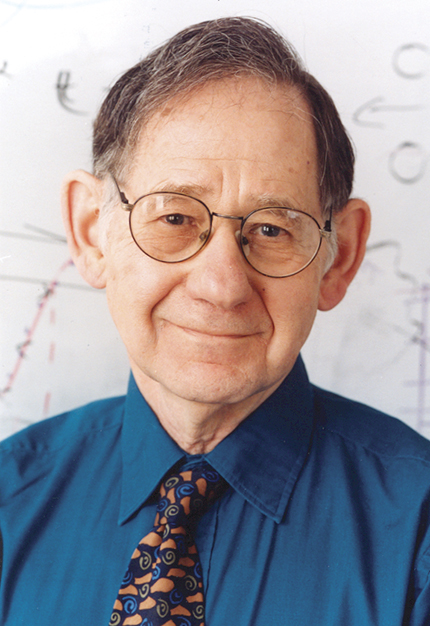Norman Julius Zabusky
DOI: 10.1063/PT.3.4004
Norman Julius Zabusky, who laid the foundations for several critical advancements in nonlinear science and experimental mathematics, died of idiopathic pulmonary fibrosis on 5 February 2018 in Beersheba, Israel. He also made fundamental contributions to computational fluid dynamics and advocated the importance of visualization in science.

Norman Julius Zabusky

Born in Brooklyn, New York, on 4 January 1929, Norman received a bachelor’s degree in electrical engineering from the City College of New York in 1951 and a master’s degree in the same subject from MIT in 1953. He earned his PhD from Caltech in 1959; his doctoral thesis, “Hydromagnetic stability of a streaming cylindrical plasma,” was done under the supervision of Milton Plesset and Leverett Davis Jr. In 1959 Norman became a postdoc at the Max Planck Institute for Physics in Munich, and in 1960 he was hired as a researcher in Princeton University’s Plasma Physics Laboratory.
The next year Norman went to Bell Labs; in 1968 he became the head of its new computational research department. After working as a mathematics professor at the University of Pittsburgh from 1976 to 1988, he joined Rutgers University as the State of New Jersey Professor of Computational Fluid Dynamics. In 2000 he was appointed as the Donald H. Jacobs Chair in Applied Physics. In the early 1990s, Norman helped found the Laboratory for Visiometrics and Modeling, and he helped direct it until his retirement in 2006. He then became a visiting scientist at the Weizmann Institute of Science in Israel.
Norman received several honors for his scientific contributions. Highlights include the Franklin Institute’s 1986 Howard N. Potts Medal (jointly with Martin Kruskal) and the American Physical Society’s 2003 Otto Laporte Award.
The narrative of how Norman and Martin came to identify the particle-like waves of translation known as solitons illustrates beautifully how courageous researchers, by delving into unusual findings, can greatly expand our scientific understanding. The observations that they pursued came from a numerical experiment reported in 1953 by Enrico Fermi, John Pasta, Stanislaw Ulam, and Mary Tsingou in what is now known as the FPUT problem. Modeling a heat-conducting solid as a lattice of coupled, weakly nonlinear springs, they surmised that the spring forces’ nonlinear nature would cause energy placed initially in a single mode to spread to all modes and equilibrate, analogous to the state of thermal equilibrium in a gas. Unexpectedly, energy did not partition equally among all modes, as the initial mode recurred. That result challenged and confounded many notable scientists.
By taking a continuum limit, Norman and Martin arrived at the Korteweg–de Vries (KdV) equation, known to describe long waves in shallow water and to have pulse-like traveling-wave solutions. Norman and Martin’s KdV computations revealed a surprising result: The pulses pass through each other unhindered except for phase shifts. The two researchers named the pulses “solitons,” and they realized that the particle-like behavior indicated distinctive and as-yet-undiscovered properties of the KdV equation itself. Research into those and other nonlinear waves grew out of that remarkable observation and has led to significant developments in numerous fields, including physics, mathematics, chemistry, and biology.
In his work on solitons, Norman recognized how important it was to visualize solutions of the KdV equation. He understood how visual analysis, which he and François Bitz termed “visiometrics,” could help in analyzing fluid dynamical and wave systems. Inspired by his work’s close connection to art, Norman organized the Fourth International Symposium on Science and Art in 2005.
Norman was deeply passionate about social justice and human rights and supported them in meaningful ways. He became a member of the Committee of Concerned Scientists in 1981, and he also served on its advisory board for several years. Norman was also a tireless advocate for the Soviet Union’s refuseniks, who were not allowed to emigrate to Israel and other nations.
Especially noteworthy were Norman’s efforts at a 1983 conference in Kiev. Ignoring the scrutiny of the KGB, he sought out refuseniks, who told him that they had felt ignored and forgotten. Norman detailed in a notebook what they recounted to him and reassured them that people around the world knew about their predicament. On a subsequent visit to Moscow, Norman and his family had to leave the country after the US Embassy was informed by the Soviet Academy of Sciences that their security could not be guaranteed. Following perestroika and glasnost, Norman returned to the new Russia for a conference in Kiev in 1989. Appropriately, his invitation came from Vladimir Zakharov, one of the leading Russian experts on solitons.
Norman was effervescent and a pleasure to be with, no matter the interaction—whether it was writing an article, discussing or debating a scientific or other issue, or being a guest in his home or office. His humanity stood out above all else. We miss Norman immensely.
More about the Authors
David K. Campbell. Boston University, Boston, Massachusetts.
Alan C. Newell. University of Arizona, Tucson.
Mason A. Porter. University of California, Los Angeles.
